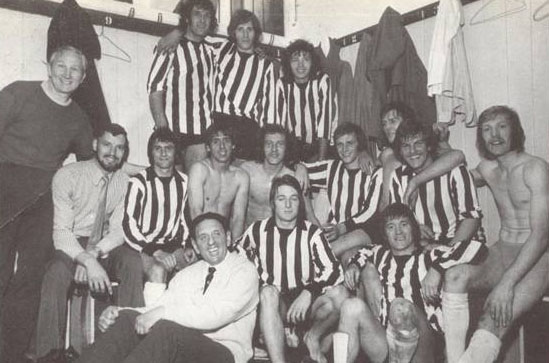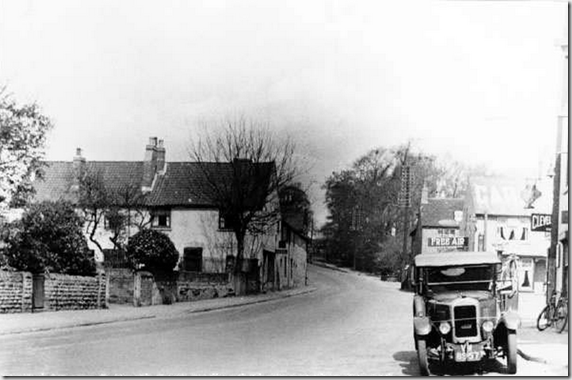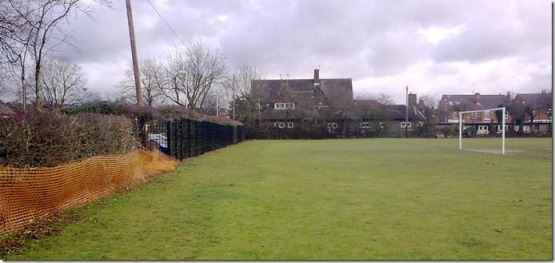Most people reading these words will know all about the ‘Master Manager’, Brian Clough and his association with the football world in the city of Nottingham but fewer will appreciate the other ‘master’ who operated a short distance away across the River Trent in the East Midlands city, Jimmy Sirrel.

Jimmy managed the less fashionable Trentside club, Notts. County for many years over three stays. Fondly remembered for taking the old club from the basement of English football through three promotions into the top flight, Jimmy is deservedly commemorated at his old Meadow Lane stomping ground by a stand named after him. It’s fair to say that he achieved an awful lot with very modest resources – except a shrewd eye for a footballer. Jimmy was renowned for his ‘team’ ethos – rarely if ever would he single out a player for praise but rather would offer plaudits for a good team effort. Seldom would he criticise his team in the press, unlike his opposite number across the Trent who treated us to much mirth over the years with his scathing comments! Jimmy retired only a very few years ago at an advanced age being still in demand as a scout with Derby County.
A friend and I were fortunate enough to briefly meet the little Glaswegian some months ago when he left a big impression on us. So much so in fact that Barbara and I had made an issue about our meeting him again some time. Many a Friday morning we’d meet up for a country walk hoping to bump into him in the same place afterwards for a more prolonged chat at the same pub. It became a bit of an in-joke joke actually as every week we wondered if it would be ‘the week’ when we finally saw him again. Barbara even began writing a book for her creative writing classes and called it ‘Looking for Jimmy Sirrel’.
As we came to the end our latest riverside walk on a Friday lunchtime we headed for the familiar Cross Keys pub in the pretty village of Burton Joyce in Nottinghamshire and there he finally was – sitting alone having a quiet drink out in the sunshine. We greeted him and he smiled warmly while asking us to join him. The first thing we did of course was have that long-awaited photograph call with him.
Jimmy still retains an impish sense of humour and keen knowledge of the game though now an impressive slim and sturdy eighty-four years old. When one talks to him he comes across very much as a working class man and in particular a football man – one with the game running strongly in his blood even still. Barbara commented afterwards that the Scottish link between he and I helped the conversation along too! What followed left me feeling quite honoured that I’d been able to spend some quality time with this man.
I began talking to him about a recent interview he’d participated in for a local magazine and I dared to venture that he saw football as very much a simple game? His answer was hardly the one I’d expected as he maintained that it was ‘far more complicated than that’ and how on earth would players come to be internationals if it was such a simple matter! I asked him what it was he looked for in a player when he was scouting for new blood for his teams. What followed was a story using Gordon Strachan as an example, and how he had trailed him for Notts County whilst the young midfielder was playing for Dundee. The game he attended was at Queen of the South I believe he said. It was a miserable, wet night for a game of football and according to Jimmy; wee Gordon just wasn’t interested and shirked out of the game. Singularly still unimpressed, Jimmy labelled his performance a ‘cheat’ and still has little respect for him it seems. He further maintained that Strachan would only play well on one the side of the pitch at Old Trafford – the side where the Man Utd support largely was!
Jimmy played on the right wing for Celtic in the days leading up to the Famous Five during the 1940s’. He did say what a wonderful and flowing forward line they were, so good to watch. He mentioned his direct opponent, Hibs left back of the time as being a right hard little ****er! A friend’s research tells me that this opponent was probably Hugh Howie who gave service to the Leith club for several seasons.
During the conversation Jimmy had mentioned his friend ‘Alex’, and that this friend was away in Europe at the moment but that he was hoping to see him soon for their traditional annual break in Malta. Barbara and I imagined that ‘Alex’ was some guy from the pub until things became clearer. ‘Alex’ was actually Jimmy’s long-time friend, Alex Ferguson. When asked how they had got to know each other he said it was through the old Anglo-Scottish competition when Ferguson was St. Mirren boss and Jimmy was at Notts. To this day after all those years the two Scots have remained close friends.

We next chatted about some of the players he had handled and the subject of former Scottish internationalist, Don Masson came up at my instigation – one of my favourite players and Jimmy’s long-time captain at Notts. I said I’d heard what a difficult character he could be and Jimmy said that he was always agreeable with him but that sometimes he had to pull ‘The Don’ up about the way he spoke to other players. Masson – never a man to suffer fools gladly would apparently become very frustrated that his teammates couldn’t live up to his own extremely high standards. Jimmy also related an amusing tale about when Masson was transferred to QPR just before his international career began.
Apparently, Jimmy and Don travelled down on the train to London for transfer talks. Jimmy told his player to, on no account sign a deal as he could get him more money elsewhere. Masson met Jim Gregory the infamous QPR chairman and immediately came out of Gregory’s office having signed a deal to play for the London club! Jimmy was aghast. A couple of days later Tommy Docherty, then Man Utd boss, was on the phone to Jimmy saying ‘what the **** are you doing to me?’ Apparently ‘The Doc and Jimmy had set up a deal for Masson to run the midfield for Manchester United…
Being a man from a different generation reared its head a time or two. Jimmy talked fondly of his now deceased former player Pedro Richards – a fine defender for Notts County. Jimmy added that he had a couple of black players in his team and used a term that whilst not as offensive as some we hear nowadays would nevertheless still be inaproppriate today. There was no malice intended. I firmly believe the only thing that would have been on Jimmy Sirrel’s mind was ‘can they play football?’ He told me how much he loved those two lads too and how he missed Pedro.
There were other more comical tales from Meadow Lane and Bramall Lane where he managed Sheffield United for a time. Jimmy mentioned that he would peer through his office window and watch the players troop in for training in the morning and sometimes have to take one aside for a dressing down for some misdemeanour or other. He claimed that more than once he threw a player against his office wall for messing him around, one even turning into a full-blown fight! He then went on complain about players’ wives who he said caused him more bother than most players! His example was on selling Sheffield Utd’s top player to Leeds one time. He mentioned the pressure from the chairman to find some cash and that the player was the only one that was worth anything to sell. Apparently, the player’s wife was straight on the phone asking what the hell was going on with her husband and giving Jimmy hell!
Still on the subject of Notts, he talked fondly of the club’s trips abroad in the close season during the 1970s. One in particular to Gibraltar where he was assigned pocket money by the Notts chairman, Jack Dunnet to hand out to the players if they ‘showed good behaviour’! Still on Notts, he turned to the subject of goalkeepers – the ‘most important man in the team’ according to Jimmy. On one occasion he toured Europe for two full weeks before finally ringing back to Chairman Jack Dunnet saying that he had found ‘a goalie who would keep them in the Second Division’. The player was Raddy Avramovic who cost Notts £200,000 – big money for Notts in those days. Raddy and his family stayed at Jimmy’s house at first until they bought a home of their own. At the beginning of the goalie’s career at Notts there was a social function at which Raddy went around and bought all his new teammates a drink as a friendly gesture. A local Evening Post reporter who followed Notts around saw this and wrote a piece about Raddy being a ‘boozer’ and a ‘big-time-Charlie’. The next time that same reporter went to Meadow Lane, Jimmy physically had hold of him and had him thrown off the premises and further banned from the ground! The Evening Post had to give the reporter the Forest job whilst the City Ground reporter switched over to Notts!
Revisiting Jimmy’s youth in the 1930s and 1940s proved a fascinating conversation. We talked of the razor gangs and ‘malky’s’ in Glasgow of that time and in particular his own area of Bridgeton. He said that he could never see any point in getting mixed up in that business and stayed well clear of the religious problems in the city as a young man. He did mention almost getting a ‘chib’ at a dance hall one night whereupon he decided on finding another more suitable establishment for his evening’s entertainment!
Jimmy went to sea in the war years and came back to begin his professional football career. He mentioned that he was actually offered contracts by Celtic, Rangers and Arsenal. He told of his train journey to London with his wife to visit Herbert Chapman the legendary manager of Arsenal. ‘I didn’t like it there much and I told him so’ said Jimmy! He was straight back on the train and signed for Celtic in the first instance.
Pausing for a moment, the great man insisted he brought us a couple of pictures to view that he happened to have in his car. Most striking was the one of him and a very young Brian Clough, Derby manager at that time, standing in a group shot at a charity function. Brian had on a very fetching pair of slacks of the time. He mentioned how much he liked his adversary across the river, how got on with him really well and now he missed him. It struck me that it would have been most unlikely for these two men not to get along, their integrity, working-class common sense and shared values would not have allowed for that.
We broached the modern game and Jimmy had some amusing insights to offer. He claimed that the sight of managers prancing about on the sidelines shouting to players on the pitch was a load of contrived nonsense for the sake of the TV cameras (only he didn’t say ‘contrived nonsense’!) He claimed that when out there, probably the only player he might be able to make himself heard to was his near-side winger – if he was lucky. He added that he thought many modern-day managers were just ‘actors’, with ill-disguised scorn at their antics.
Towards the end of our conversation which lasted fully two hours we got talking about the great Scottish wing half, Dave Mackay who also lives locally and who Jimmy had known for many years. I ventured he was one of the very greatest men to wear our proud Dark Blue of Scotland. (I had to keep remembering when talking about football that I know nothing really whilst this man knew the game inside out!) Jimmy agreed that ‘David’ was a great player but also a ‘vicious bastard’!
I popped into the pub before we said our goodbyes to Jimmy. There was another familiar-sounding Scottish accent greeting me in there ‘lovely day out there eh’… Yes it was Dave Mackay! What a surreal moment.
The final thought I had about this conversation was of how Jimmy saw footballers. It perhaps IS a simple game in some respects. According to him ‘all you need for a good team is the best players’ – it’s as simple as that. If he could afford a player who was better in a certain position on his team than the one he already had he said then he would go and get him. He thought little of 4-4-2, 3-5-2 and all. All you need is the best players. I came away from this lovely afternoon understanding that I had just been blessed with the company of one of the game’s most accomplished, knowledgeable and best ever managers. A private audience with one of the men I admired most in football. Now that memory will live with me forever.
The legend – Jimmy Sirrel.











 y in articles featuring
y in articles featuring  Post Features Editor, Jeremy Lewis was an interesting experience to say the least. Mr. Williams, a very accomplished man and former editor of three large local newspapers for many years including the afore-mentioned Nottingham edition was in Lowdham to talk about his recently written autobiography and seemed to have attracted many of his former work colleagues from the local newspaper to see him. I was struck by this at once as one of the old hacks sat next to me with a loud, self-important and booming voice appeared to believe I was a piece of furniture to be leaned on. Perhaps there had been a few gin and tonics over lunch I mused as I pulled my chair away from his weight. It must actually be a common ignorance that some old journalists have as another of his blue-blazered ‘chums’ appeared to consider my shoulder as a convenient leaning post before I physically took his arm and removed it to his surprise.
Post Features Editor, Jeremy Lewis was an interesting experience to say the least. Mr. Williams, a very accomplished man and former editor of three large local newspapers for many years including the afore-mentioned Nottingham edition was in Lowdham to talk about his recently written autobiography and seemed to have attracted many of his former work colleagues from the local newspaper to see him. I was struck by this at once as one of the old hacks sat next to me with a loud, self-important and booming voice appeared to believe I was a piece of furniture to be leaned on. Perhaps there had been a few gin and tonics over lunch I mused as I pulled my chair away from his weight. It must actually be a common ignorance that some old journalists have as another of his blue-blazered ‘chums’ appeared to consider my shoulder as a convenient leaning post before I physically took his arm and removed it to his surprise.





![[image]](https://i0.wp.com/webzoom.freewebs.com/stuartfrew/Blog%20Images/Bestwood_Lodge_Htel.jpg)



